Analyzing ABC Costing Model for Managerial Accounting Decisions
VerifiedAdded on 2021/05/31
|12
|2961
|31
Report
AI Summary
This report provides a comprehensive overview of the Activity-Based Costing (ABC) model and its significance in managerial accounting. It begins with an executive summary highlighting the importance of ABC for managerial decision-making, emphasizing its ability to categorize costs based on business activities. The report then delves into the features of the ABC model, explaining its principles, and how it aids in allocating indirect costs more accurately than traditional methods. It uses IPH Limited as a case study, analyzing its mission, vision, and objectives, as well as its corporate strategies. The report details how the adoption of the ABC model can assist the company in achieving its goals by improving cost analysis and strategic decision-making. Recommendations are provided for the implementation of the ABC model, along with a discussion of other management tools. Finally, the report concludes by summarizing the key findings and benefits of the ABC costing model.

Running head: MANAGERIAL ACCOUNTING
Managerial Accounting
Name of the Student:
Name of the university:
Authors Note:
Managerial Accounting
Name of the Student:
Name of the university:
Authors Note:
Paraphrase This Document
Need a fresh take? Get an instant paraphrase of this document with our AI Paraphraser

1MANAGERIAL ACCOUNTING
Executive summary:
The importance and the relevance of the ABC costing model has been discussed in the
following report. For the purpose of factoring in the importance that is presented by the
method to the management for the purpose of decision making, the various features
characteristics and the advantages of the system have been discussed. It is found that the
method is able to create immense value for the management of the company due to the fact
that the cost incurred by the entity is divided into several categories and the categorisation of
the costs incurred is done based on the activities that are being performed by the entity for
conducting its business.
Executive summary:
The importance and the relevance of the ABC costing model has been discussed in the
following report. For the purpose of factoring in the importance that is presented by the
method to the management for the purpose of decision making, the various features
characteristics and the advantages of the system have been discussed. It is found that the
method is able to create immense value for the management of the company due to the fact
that the cost incurred by the entity is divided into several categories and the categorisation of
the costs incurred is done based on the activities that are being performed by the entity for
conducting its business.
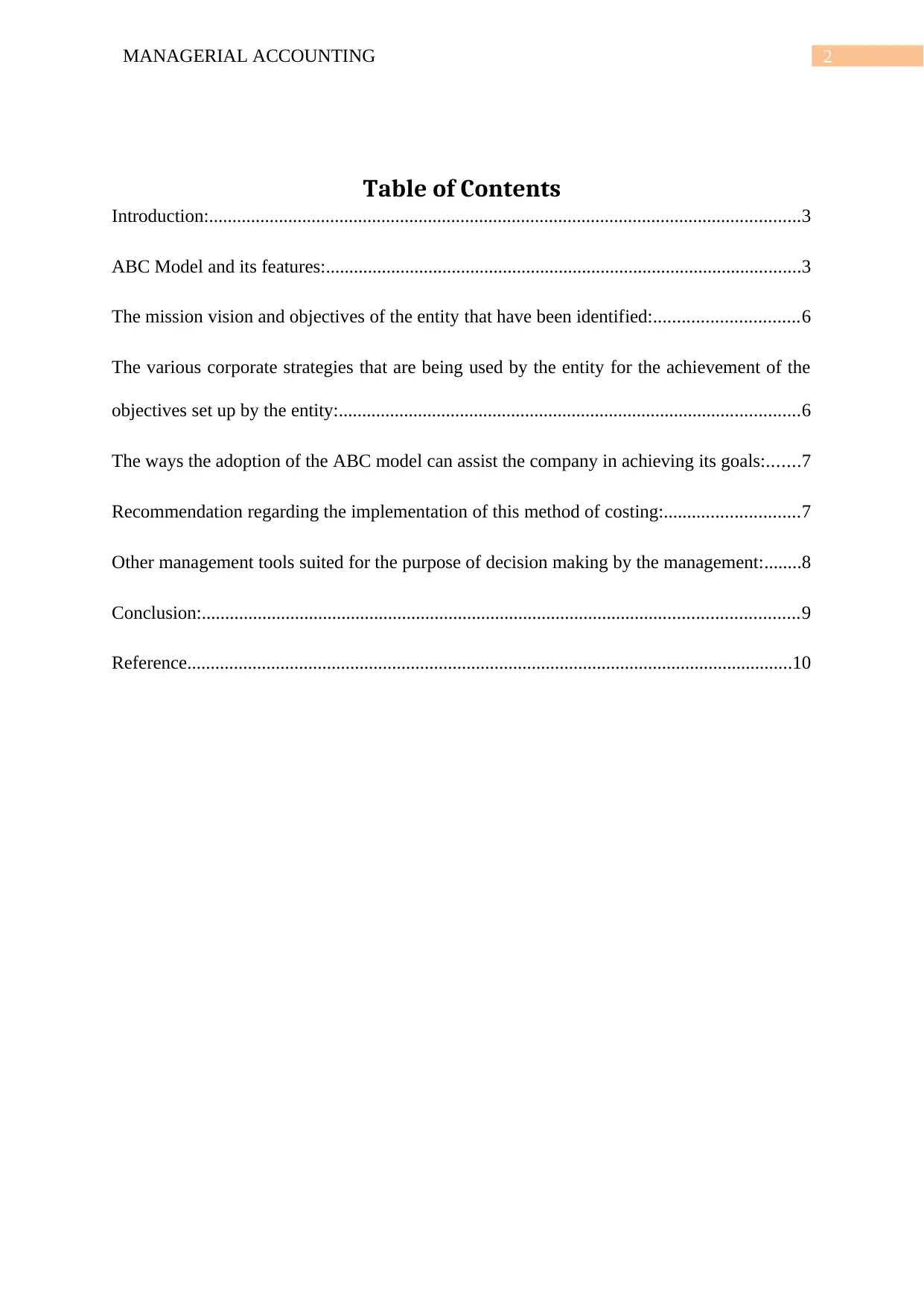
2MANAGERIAL ACCOUNTING
Table of Contents
Introduction:...............................................................................................................................3
ABC Model and its features:......................................................................................................3
The mission vision and objectives of the entity that have been identified:...............................6
The various corporate strategies that are being used by the entity for the achievement of the
objectives set up by the entity:...................................................................................................6
The ways the adoption of the ABC model can assist the company in achieving its goals:.......7
Recommendation regarding the implementation of this method of costing:.............................7
Other management tools suited for the purpose of decision making by the management:........8
Conclusion:................................................................................................................................9
Reference..................................................................................................................................10
Table of Contents
Introduction:...............................................................................................................................3
ABC Model and its features:......................................................................................................3
The mission vision and objectives of the entity that have been identified:...............................6
The various corporate strategies that are being used by the entity for the achievement of the
objectives set up by the entity:...................................................................................................6
The ways the adoption of the ABC model can assist the company in achieving its goals:.......7
Recommendation regarding the implementation of this method of costing:.............................7
Other management tools suited for the purpose of decision making by the management:........8
Conclusion:................................................................................................................................9
Reference..................................................................................................................................10
⊘ This is a preview!⊘
Do you want full access?
Subscribe today to unlock all pages.

Trusted by 1+ million students worldwide
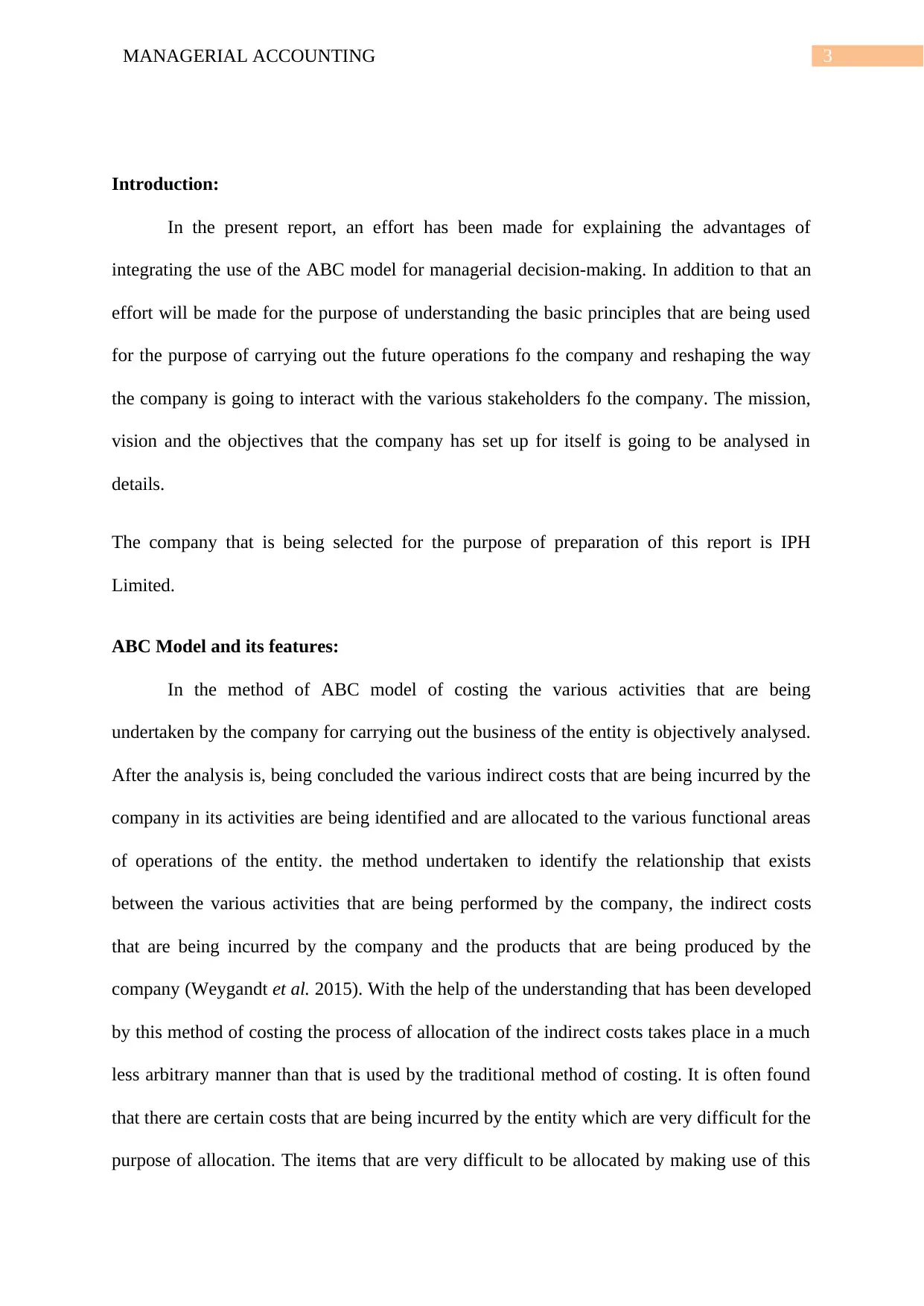
3MANAGERIAL ACCOUNTING
Introduction:
In the present report, an effort has been made for explaining the advantages of
integrating the use of the ABC model for managerial decision-making. In addition to that an
effort will be made for the purpose of understanding the basic principles that are being used
for the purpose of carrying out the future operations fo the company and reshaping the way
the company is going to interact with the various stakeholders fo the company. The mission,
vision and the objectives that the company has set up for itself is going to be analysed in
details.
The company that is being selected for the purpose of preparation of this report is IPH
Limited.
ABC Model and its features:
In the method of ABC model of costing the various activities that are being
undertaken by the company for carrying out the business of the entity is objectively analysed.
After the analysis is, being concluded the various indirect costs that are being incurred by the
company in its activities are being identified and are allocated to the various functional areas
of operations of the entity. the method undertaken to identify the relationship that exists
between the various activities that are being performed by the company, the indirect costs
that are being incurred by the company and the products that are being produced by the
company (Weygandt et al. 2015). With the help of the understanding that has been developed
by this method of costing the process of allocation of the indirect costs takes place in a much
less arbitrary manner than that is used by the traditional method of costing. It is often found
that there are certain costs that are being incurred by the entity which are very difficult for the
purpose of allocation. The items that are very difficult to be allocated by making use of this
Introduction:
In the present report, an effort has been made for explaining the advantages of
integrating the use of the ABC model for managerial decision-making. In addition to that an
effort will be made for the purpose of understanding the basic principles that are being used
for the purpose of carrying out the future operations fo the company and reshaping the way
the company is going to interact with the various stakeholders fo the company. The mission,
vision and the objectives that the company has set up for itself is going to be analysed in
details.
The company that is being selected for the purpose of preparation of this report is IPH
Limited.
ABC Model and its features:
In the method of ABC model of costing the various activities that are being
undertaken by the company for carrying out the business of the entity is objectively analysed.
After the analysis is, being concluded the various indirect costs that are being incurred by the
company in its activities are being identified and are allocated to the various functional areas
of operations of the entity. the method undertaken to identify the relationship that exists
between the various activities that are being performed by the company, the indirect costs
that are being incurred by the company and the products that are being produced by the
company (Weygandt et al. 2015). With the help of the understanding that has been developed
by this method of costing the process of allocation of the indirect costs takes place in a much
less arbitrary manner than that is used by the traditional method of costing. It is often found
that there are certain costs that are being incurred by the entity which are very difficult for the
purpose of allocation. The items that are very difficult to be allocated by making use of this
Paraphrase This Document
Need a fresh take? Get an instant paraphrase of this document with our AI Paraphraser
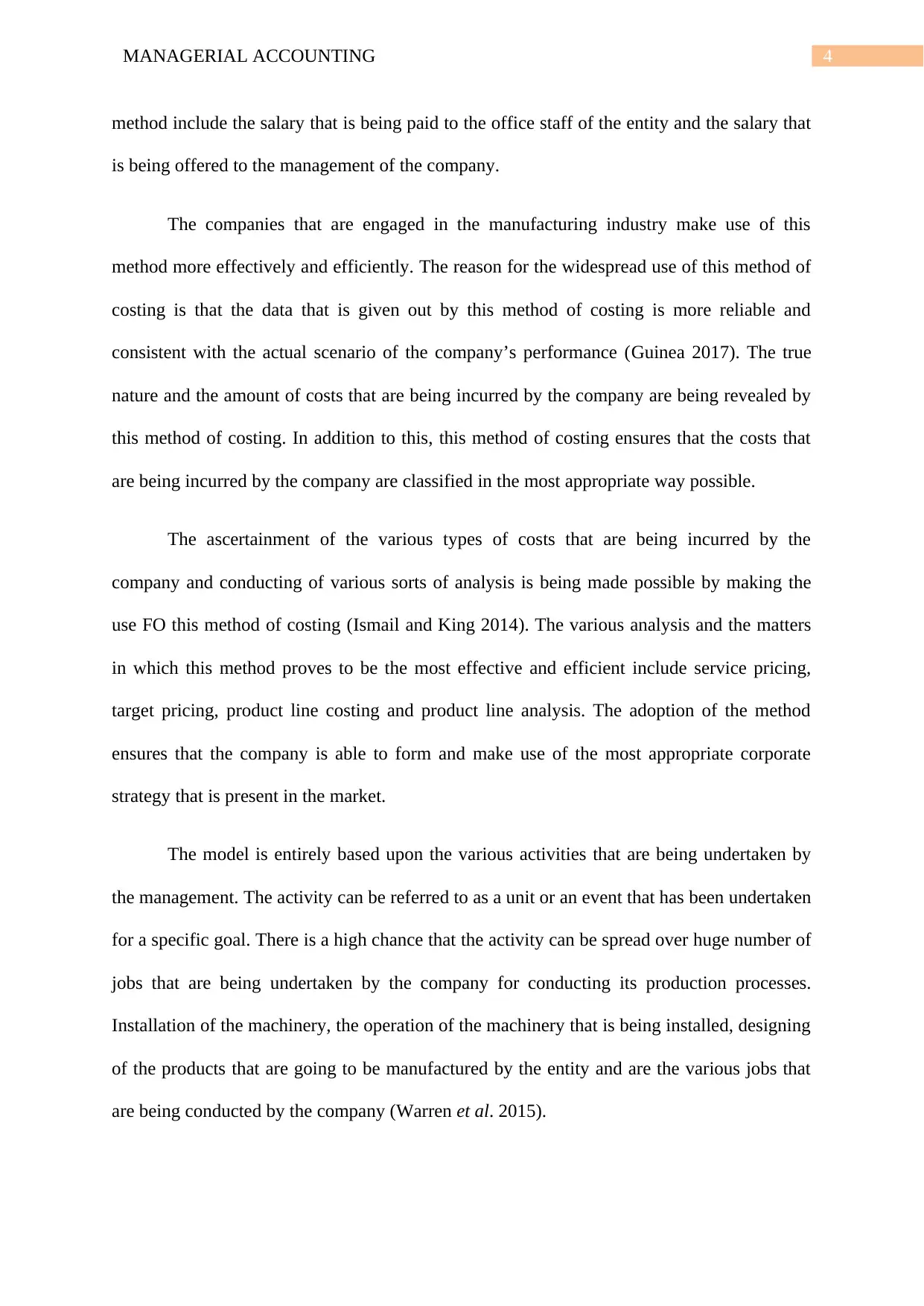
4MANAGERIAL ACCOUNTING
method include the salary that is being paid to the office staff of the entity and the salary that
is being offered to the management of the company.
The companies that are engaged in the manufacturing industry make use of this
method more effectively and efficiently. The reason for the widespread use of this method of
costing is that the data that is given out by this method of costing is more reliable and
consistent with the actual scenario of the company’s performance (Guinea 2017). The true
nature and the amount of costs that are being incurred by the company are being revealed by
this method of costing. In addition to this, this method of costing ensures that the costs that
are being incurred by the company are classified in the most appropriate way possible.
The ascertainment of the various types of costs that are being incurred by the
company and conducting of various sorts of analysis is being made possible by making the
use FO this method of costing (Ismail and King 2014). The various analysis and the matters
in which this method proves to be the most effective and efficient include service pricing,
target pricing, product line costing and product line analysis. The adoption of the method
ensures that the company is able to form and make use of the most appropriate corporate
strategy that is present in the market.
The model is entirely based upon the various activities that are being undertaken by
the management. The activity can be referred to as a unit or an event that has been undertaken
for a specific goal. There is a high chance that the activity can be spread over huge number of
jobs that are being undertaken by the company for conducting its production processes.
Installation of the machinery, the operation of the machinery that is being installed, designing
of the products that are going to be manufactured by the entity and are the various jobs that
are being conducted by the company (Warren et al. 2015).
method include the salary that is being paid to the office staff of the entity and the salary that
is being offered to the management of the company.
The companies that are engaged in the manufacturing industry make use of this
method more effectively and efficiently. The reason for the widespread use of this method of
costing is that the data that is given out by this method of costing is more reliable and
consistent with the actual scenario of the company’s performance (Guinea 2017). The true
nature and the amount of costs that are being incurred by the company are being revealed by
this method of costing. In addition to this, this method of costing ensures that the costs that
are being incurred by the company are classified in the most appropriate way possible.
The ascertainment of the various types of costs that are being incurred by the
company and conducting of various sorts of analysis is being made possible by making the
use FO this method of costing (Ismail and King 2014). The various analysis and the matters
in which this method proves to be the most effective and efficient include service pricing,
target pricing, product line costing and product line analysis. The adoption of the method
ensures that the company is able to form and make use of the most appropriate corporate
strategy that is present in the market.
The model is entirely based upon the various activities that are being undertaken by
the management. The activity can be referred to as a unit or an event that has been undertaken
for a specific goal. There is a high chance that the activity can be spread over huge number of
jobs that are being undertaken by the company for conducting its production processes.
Installation of the machinery, the operation of the machinery that is being installed, designing
of the products that are going to be manufactured by the entity and are the various jobs that
are being conducted by the company (Warren et al. 2015).
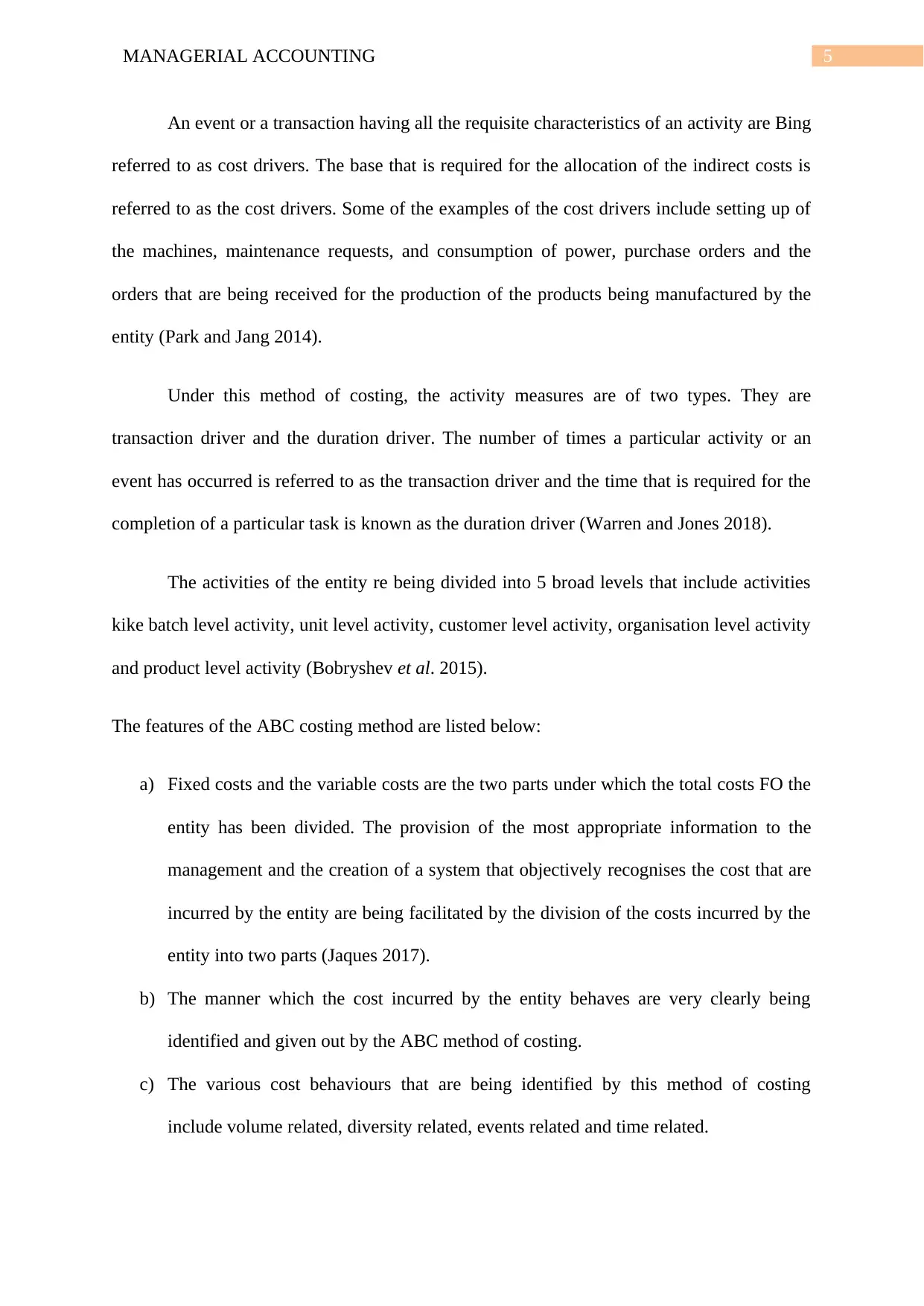
5MANAGERIAL ACCOUNTING
An event or a transaction having all the requisite characteristics of an activity are Bing
referred to as cost drivers. The base that is required for the allocation of the indirect costs is
referred to as the cost drivers. Some of the examples of the cost drivers include setting up of
the machines, maintenance requests, and consumption of power, purchase orders and the
orders that are being received for the production of the products being manufactured by the
entity (Park and Jang 2014).
Under this method of costing, the activity measures are of two types. They are
transaction driver and the duration driver. The number of times a particular activity or an
event has occurred is referred to as the transaction driver and the time that is required for the
completion of a particular task is known as the duration driver (Warren and Jones 2018).
The activities of the entity re being divided into 5 broad levels that include activities
kike batch level activity, unit level activity, customer level activity, organisation level activity
and product level activity (Bobryshev et al. 2015).
The features of the ABC costing method are listed below:
a) Fixed costs and the variable costs are the two parts under which the total costs FO the
entity has been divided. The provision of the most appropriate information to the
management and the creation of a system that objectively recognises the cost that are
incurred by the entity are being facilitated by the division of the costs incurred by the
entity into two parts (Jaques 2017).
b) The manner which the cost incurred by the entity behaves are very clearly being
identified and given out by the ABC method of costing.
c) The various cost behaviours that are being identified by this method of costing
include volume related, diversity related, events related and time related.
An event or a transaction having all the requisite characteristics of an activity are Bing
referred to as cost drivers. The base that is required for the allocation of the indirect costs is
referred to as the cost drivers. Some of the examples of the cost drivers include setting up of
the machines, maintenance requests, and consumption of power, purchase orders and the
orders that are being received for the production of the products being manufactured by the
entity (Park and Jang 2014).
Under this method of costing, the activity measures are of two types. They are
transaction driver and the duration driver. The number of times a particular activity or an
event has occurred is referred to as the transaction driver and the time that is required for the
completion of a particular task is known as the duration driver (Warren and Jones 2018).
The activities of the entity re being divided into 5 broad levels that include activities
kike batch level activity, unit level activity, customer level activity, organisation level activity
and product level activity (Bobryshev et al. 2015).
The features of the ABC costing method are listed below:
a) Fixed costs and the variable costs are the two parts under which the total costs FO the
entity has been divided. The provision of the most appropriate information to the
management and the creation of a system that objectively recognises the cost that are
incurred by the entity are being facilitated by the division of the costs incurred by the
entity into two parts (Jaques 2017).
b) The manner which the cost incurred by the entity behaves are very clearly being
identified and given out by the ABC method of costing.
c) The various cost behaviours that are being identified by this method of costing
include volume related, diversity related, events related and time related.
⊘ This is a preview!⊘
Do you want full access?
Subscribe today to unlock all pages.

Trusted by 1+ million students worldwide

6MANAGERIAL ACCOUNTING
d) The most appropriate cost drivers are being identified by this ethos of costing for the
proper tracing of the overhead to a particular product.
e) The cost behaviours patterns are always directed by the cost drivers that are present
within the entity (Pelger and Schäfer 2018).
The mission vision and objectives of the entity that have been identified:
Some of the key mission and vison of the entity are can be stated as follows:
a) Increasing the innovation in the product and services and within the culture of the
entity:
The company aims at improving the performance that is recorded by it by making the
approach and the production process very innovative and dynamic. The reason for this
is that the company wants to keep up with the changing times.
b) Increasing the returns that is generated for the shareholders of the company-
By increasing the efficiency of the operations and increasing the revenue that is being
generated by the entity, it is trying to create immense value for the shareholders of the
company (Glover and Lin 2018).
The various corporate strategies that are being used by the entity for the achievement of
the objectives set up by the entity:
The various corporate strategies that are being adopted by the company for the purpose of
accomplishment of the objectives are as flows:
a) Australian IP business:
The main purpose of this strategy is to organically grow the volume of the IP filings,
increase the market share and the revenue all across the sectors.
d) The most appropriate cost drivers are being identified by this ethos of costing for the
proper tracing of the overhead to a particular product.
e) The cost behaviours patterns are always directed by the cost drivers that are present
within the entity (Pelger and Schäfer 2018).
The mission vision and objectives of the entity that have been identified:
Some of the key mission and vison of the entity are can be stated as follows:
a) Increasing the innovation in the product and services and within the culture of the
entity:
The company aims at improving the performance that is recorded by it by making the
approach and the production process very innovative and dynamic. The reason for this
is that the company wants to keep up with the changing times.
b) Increasing the returns that is generated for the shareholders of the company-
By increasing the efficiency of the operations and increasing the revenue that is being
generated by the entity, it is trying to create immense value for the shareholders of the
company (Glover and Lin 2018).
The various corporate strategies that are being used by the entity for the achievement of
the objectives set up by the entity:
The various corporate strategies that are being adopted by the company for the purpose of
accomplishment of the objectives are as flows:
a) Australian IP business:
The main purpose of this strategy is to organically grow the volume of the IP filings,
increase the market share and the revenue all across the sectors.
Paraphrase This Document
Need a fresh take? Get an instant paraphrase of this document with our AI Paraphraser

7MANAGERIAL ACCOUNTING
b) Asian IP business:
The company is focussed in growing its operations in the Asian market. For achieving
that, the company has opened its branches in Thailand, Indonesia and even China.
The ways the adoption of the ABC model can assist the company in achieving its goals:
Every corporate entity engages in the setting up of several objectives that are to be
fulfilled by it over the period of operations of the entity. For the purpose of accomplishment
of these objectives, it is absolutely needed that the company engages in the monitoring of
various aspects of the business. One of the most important aspects of the business is the cost
that is incurred by the company in respect of the various activities that are being conducted
by the company (Hiebl et al. 2015). The ABC model draws the relationship between the cost
that has been incurred by the entity and the revenue that has been generated by the avenue in
its favour.
The method establishes the fixed costs that are going to be incurred by the company
irrespective of the level of production of the company. After the establishment of the costs to
be incurred, the method can establish the amount of the benefit that has been generated in the
favour of the entity in return of the money that has been spent by it.
The method provides the entity with crucial data relating to the nature of the costs that are
incurred by the entity with the help of segregation of the costs based on their respective
behaviours. The cost behaviours can be segregated into five models i.e. volume related,
diversity related, events related and time related (Richardson et al. 2014).
Recommendation regarding the implementation of this method of costing:
The various recommendations that can be made in respect of the implementation of the ABC
model of costing are as follows:
b) Asian IP business:
The company is focussed in growing its operations in the Asian market. For achieving
that, the company has opened its branches in Thailand, Indonesia and even China.
The ways the adoption of the ABC model can assist the company in achieving its goals:
Every corporate entity engages in the setting up of several objectives that are to be
fulfilled by it over the period of operations of the entity. For the purpose of accomplishment
of these objectives, it is absolutely needed that the company engages in the monitoring of
various aspects of the business. One of the most important aspects of the business is the cost
that is incurred by the company in respect of the various activities that are being conducted
by the company (Hiebl et al. 2015). The ABC model draws the relationship between the cost
that has been incurred by the entity and the revenue that has been generated by the avenue in
its favour.
The method establishes the fixed costs that are going to be incurred by the company
irrespective of the level of production of the company. After the establishment of the costs to
be incurred, the method can establish the amount of the benefit that has been generated in the
favour of the entity in return of the money that has been spent by it.
The method provides the entity with crucial data relating to the nature of the costs that are
incurred by the entity with the help of segregation of the costs based on their respective
behaviours. The cost behaviours can be segregated into five models i.e. volume related,
diversity related, events related and time related (Richardson et al. 2014).
Recommendation regarding the implementation of this method of costing:
The various recommendations that can be made in respect of the implementation of the ABC
model of costing are as follows:
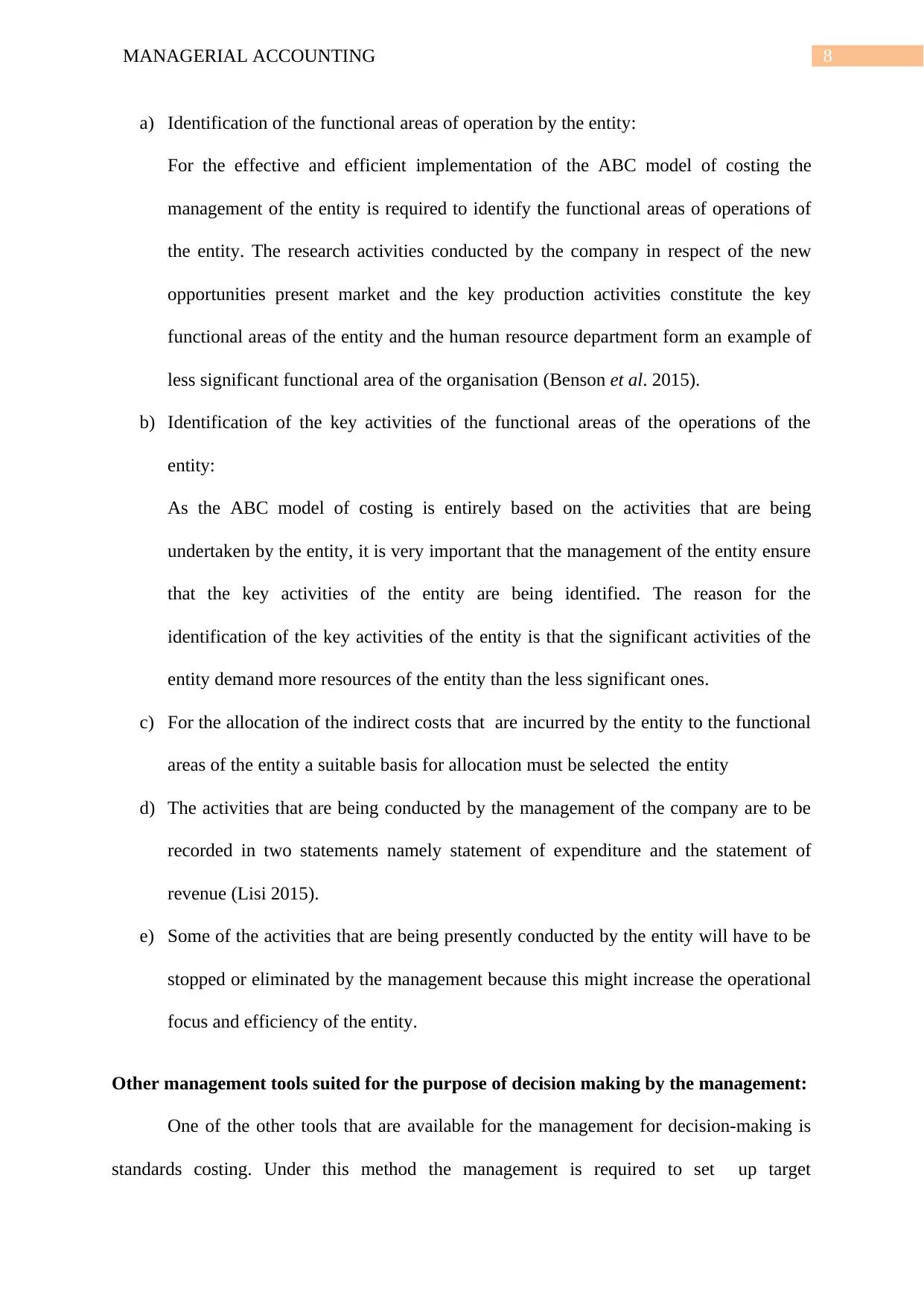
8MANAGERIAL ACCOUNTING
a) Identification of the functional areas of operation by the entity:
For the effective and efficient implementation of the ABC model of costing the
management of the entity is required to identify the functional areas of operations of
the entity. The research activities conducted by the company in respect of the new
opportunities present market and the key production activities constitute the key
functional areas of the entity and the human resource department form an example of
less significant functional area of the organisation (Benson et al. 2015).
b) Identification of the key activities of the functional areas of the operations of the
entity:
As the ABC model of costing is entirely based on the activities that are being
undertaken by the entity, it is very important that the management of the entity ensure
that the key activities of the entity are being identified. The reason for the
identification of the key activities of the entity is that the significant activities of the
entity demand more resources of the entity than the less significant ones.
c) For the allocation of the indirect costs that are incurred by the entity to the functional
areas of the entity a suitable basis for allocation must be selected the entity
d) The activities that are being conducted by the management of the company are to be
recorded in two statements namely statement of expenditure and the statement of
revenue (Lisi 2015).
e) Some of the activities that are being presently conducted by the entity will have to be
stopped or eliminated by the management because this might increase the operational
focus and efficiency of the entity.
Other management tools suited for the purpose of decision making by the management:
One of the other tools that are available for the management for decision-making is
standards costing. Under this method the management is required to set up target
a) Identification of the functional areas of operation by the entity:
For the effective and efficient implementation of the ABC model of costing the
management of the entity is required to identify the functional areas of operations of
the entity. The research activities conducted by the company in respect of the new
opportunities present market and the key production activities constitute the key
functional areas of the entity and the human resource department form an example of
less significant functional area of the organisation (Benson et al. 2015).
b) Identification of the key activities of the functional areas of the operations of the
entity:
As the ABC model of costing is entirely based on the activities that are being
undertaken by the entity, it is very important that the management of the entity ensure
that the key activities of the entity are being identified. The reason for the
identification of the key activities of the entity is that the significant activities of the
entity demand more resources of the entity than the less significant ones.
c) For the allocation of the indirect costs that are incurred by the entity to the functional
areas of the entity a suitable basis for allocation must be selected the entity
d) The activities that are being conducted by the management of the company are to be
recorded in two statements namely statement of expenditure and the statement of
revenue (Lisi 2015).
e) Some of the activities that are being presently conducted by the entity will have to be
stopped or eliminated by the management because this might increase the operational
focus and efficiency of the entity.
Other management tools suited for the purpose of decision making by the management:
One of the other tools that are available for the management for decision-making is
standards costing. Under this method the management is required to set up target
⊘ This is a preview!⊘
Do you want full access?
Subscribe today to unlock all pages.

Trusted by 1+ million students worldwide
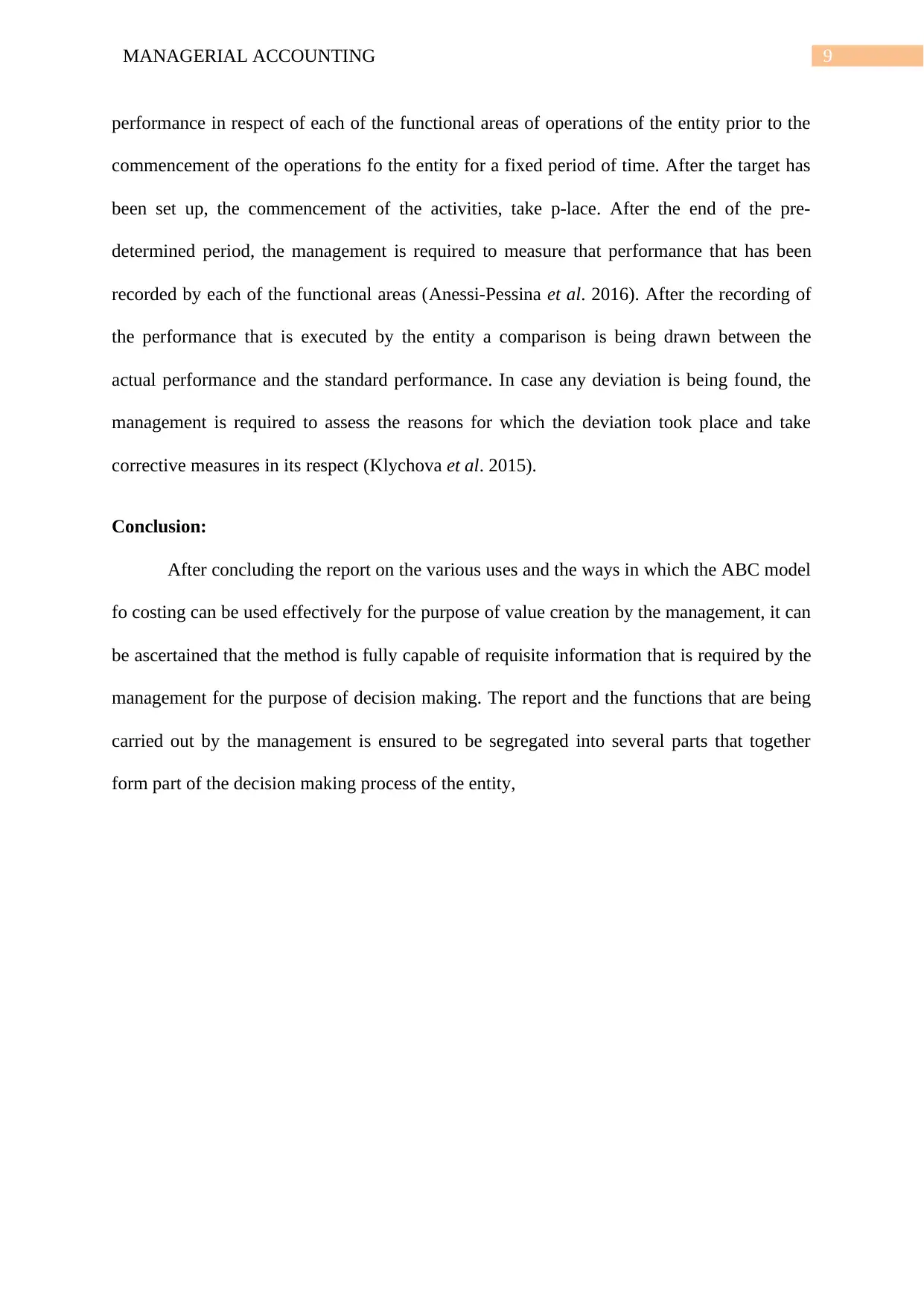
9MANAGERIAL ACCOUNTING
performance in respect of each of the functional areas of operations of the entity prior to the
commencement of the operations fo the entity for a fixed period of time. After the target has
been set up, the commencement of the activities, take p-lace. After the end of the pre-
determined period, the management is required to measure that performance that has been
recorded by each of the functional areas (Anessi-Pessina et al. 2016). After the recording of
the performance that is executed by the entity a comparison is being drawn between the
actual performance and the standard performance. In case any deviation is being found, the
management is required to assess the reasons for which the deviation took place and take
corrective measures in its respect (Klychova et al. 2015).
Conclusion:
After concluding the report on the various uses and the ways in which the ABC model
fo costing can be used effectively for the purpose of value creation by the management, it can
be ascertained that the method is fully capable of requisite information that is required by the
management for the purpose of decision making. The report and the functions that are being
carried out by the management is ensured to be segregated into several parts that together
form part of the decision making process of the entity,
performance in respect of each of the functional areas of operations of the entity prior to the
commencement of the operations fo the entity for a fixed period of time. After the target has
been set up, the commencement of the activities, take p-lace. After the end of the pre-
determined period, the management is required to measure that performance that has been
recorded by each of the functional areas (Anessi-Pessina et al. 2016). After the recording of
the performance that is executed by the entity a comparison is being drawn between the
actual performance and the standard performance. In case any deviation is being found, the
management is required to assess the reasons for which the deviation took place and take
corrective measures in its respect (Klychova et al. 2015).
Conclusion:
After concluding the report on the various uses and the ways in which the ABC model
fo costing can be used effectively for the purpose of value creation by the management, it can
be ascertained that the method is fully capable of requisite information that is required by the
management for the purpose of decision making. The report and the functions that are being
carried out by the management is ensured to be segregated into several parts that together
form part of the decision making process of the entity,
Paraphrase This Document
Need a fresh take? Get an instant paraphrase of this document with our AI Paraphraser
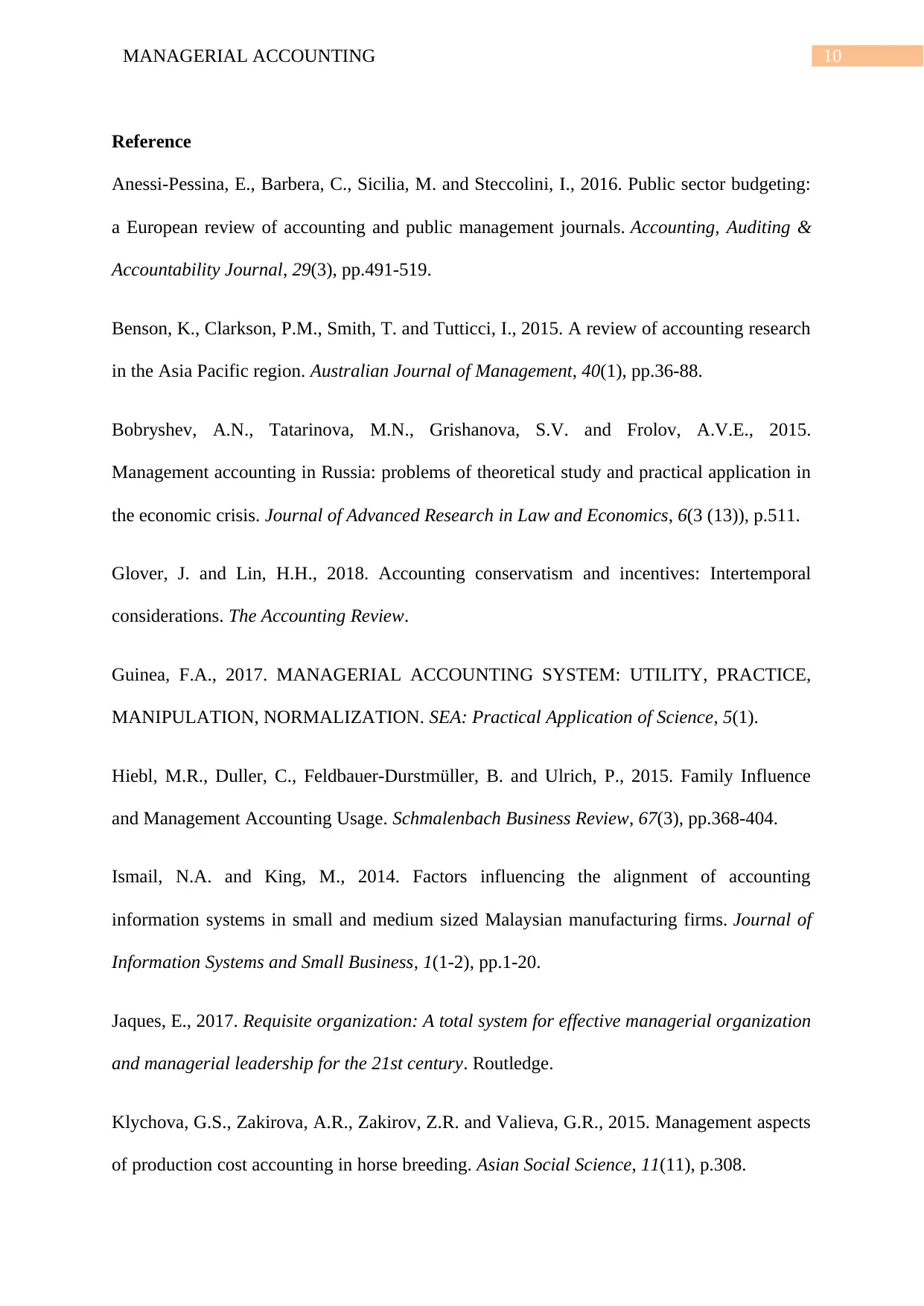
10MANAGERIAL ACCOUNTING
Reference
Anessi-Pessina, E., Barbera, C., Sicilia, M. and Steccolini, I., 2016. Public sector budgeting:
a European review of accounting and public management journals. Accounting, Auditing &
Accountability Journal, 29(3), pp.491-519.
Benson, K., Clarkson, P.M., Smith, T. and Tutticci, I., 2015. A review of accounting research
in the Asia Pacific region. Australian Journal of Management, 40(1), pp.36-88.
Bobryshev, A.N., Tatarinova, M.N., Grishanova, S.V. and Frolov, A.V.E., 2015.
Management accounting in Russia: problems of theoretical study and practical application in
the economic crisis. Journal of Advanced Research in Law and Economics, 6(3 (13)), p.511.
Glover, J. and Lin, H.H., 2018. Accounting conservatism and incentives: Intertemporal
considerations. The Accounting Review.
Guinea, F.A., 2017. MANAGERIAL ACCOUNTING SYSTEM: UTILITY, PRACTICE,
MANIPULATION, NORMALIZATION. SEA: Practical Application of Science, 5(1).
Hiebl, M.R., Duller, C., Feldbauer-Durstmüller, B. and Ulrich, P., 2015. Family Influence
and Management Accounting Usage. Schmalenbach Business Review, 67(3), pp.368-404.
Ismail, N.A. and King, M., 2014. Factors influencing the alignment of accounting
information systems in small and medium sized Malaysian manufacturing firms. Journal of
Information Systems and Small Business, 1(1-2), pp.1-20.
Jaques, E., 2017. Requisite organization: A total system for effective managerial organization
and managerial leadership for the 21st century. Routledge.
Klychova, G.S., Zakirova, A.R., Zakirov, Z.R. and Valieva, G.R., 2015. Management aspects
of production cost accounting in horse breeding. Asian Social Science, 11(11), p.308.
Reference
Anessi-Pessina, E., Barbera, C., Sicilia, M. and Steccolini, I., 2016. Public sector budgeting:
a European review of accounting and public management journals. Accounting, Auditing &
Accountability Journal, 29(3), pp.491-519.
Benson, K., Clarkson, P.M., Smith, T. and Tutticci, I., 2015. A review of accounting research
in the Asia Pacific region. Australian Journal of Management, 40(1), pp.36-88.
Bobryshev, A.N., Tatarinova, M.N., Grishanova, S.V. and Frolov, A.V.E., 2015.
Management accounting in Russia: problems of theoretical study and practical application in
the economic crisis. Journal of Advanced Research in Law and Economics, 6(3 (13)), p.511.
Glover, J. and Lin, H.H., 2018. Accounting conservatism and incentives: Intertemporal
considerations. The Accounting Review.
Guinea, F.A., 2017. MANAGERIAL ACCOUNTING SYSTEM: UTILITY, PRACTICE,
MANIPULATION, NORMALIZATION. SEA: Practical Application of Science, 5(1).
Hiebl, M.R., Duller, C., Feldbauer-Durstmüller, B. and Ulrich, P., 2015. Family Influence
and Management Accounting Usage. Schmalenbach Business Review, 67(3), pp.368-404.
Ismail, N.A. and King, M., 2014. Factors influencing the alignment of accounting
information systems in small and medium sized Malaysian manufacturing firms. Journal of
Information Systems and Small Business, 1(1-2), pp.1-20.
Jaques, E., 2017. Requisite organization: A total system for effective managerial organization
and managerial leadership for the 21st century. Routledge.
Klychova, G.S., Zakirova, A.R., Zakirov, Z.R. and Valieva, G.R., 2015. Management aspects
of production cost accounting in horse breeding. Asian Social Science, 11(11), p.308.
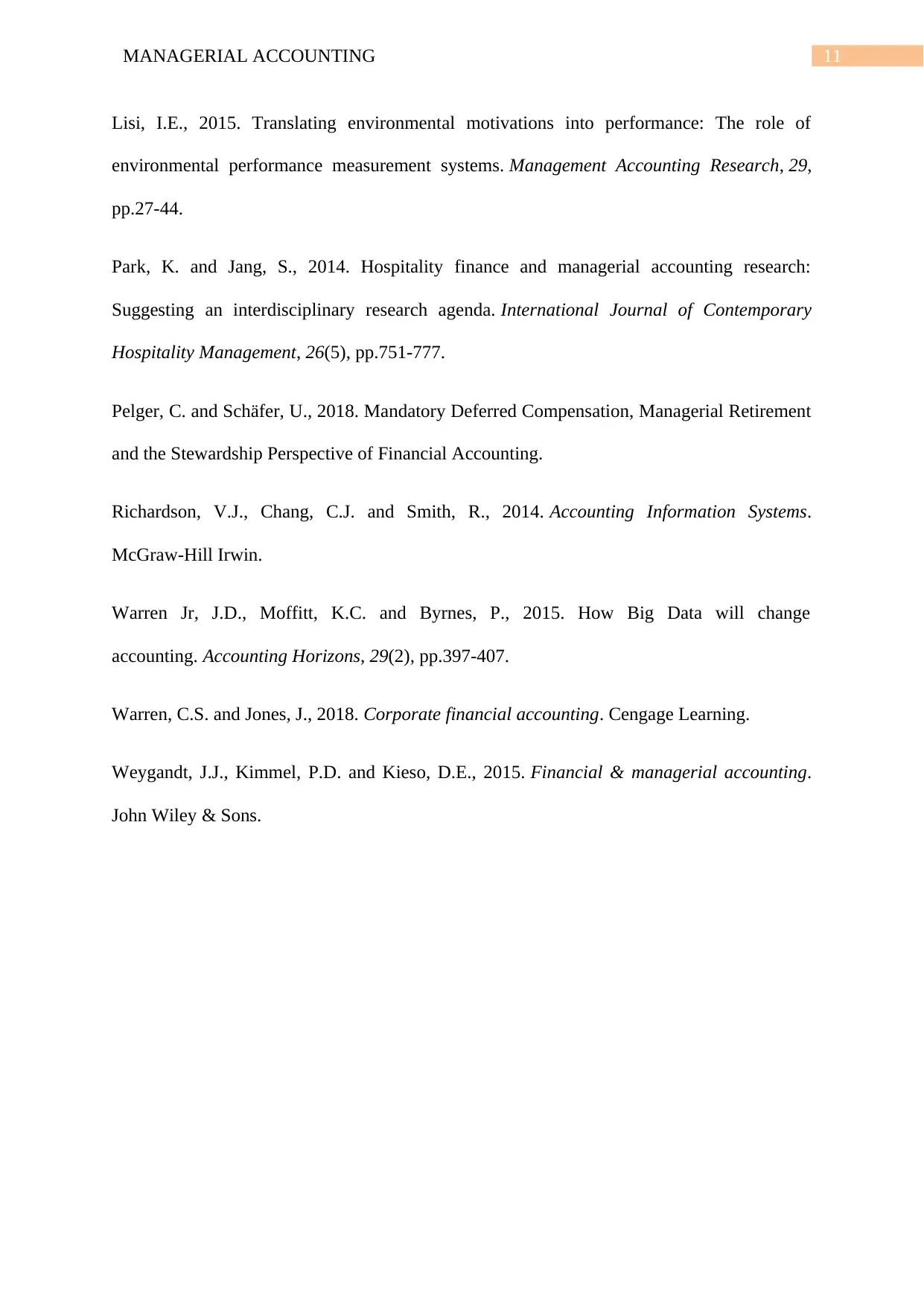
11MANAGERIAL ACCOUNTING
Lisi, I.E., 2015. Translating environmental motivations into performance: The role of
environmental performance measurement systems. Management Accounting Research, 29,
pp.27-44.
Park, K. and Jang, S., 2014. Hospitality finance and managerial accounting research:
Suggesting an interdisciplinary research agenda. International Journal of Contemporary
Hospitality Management, 26(5), pp.751-777.
Pelger, C. and Schäfer, U., 2018. Mandatory Deferred Compensation, Managerial Retirement
and the Stewardship Perspective of Financial Accounting.
Richardson, V.J., Chang, C.J. and Smith, R., 2014. Accounting Information Systems.
McGraw-Hill Irwin.
Warren Jr, J.D., Moffitt, K.C. and Byrnes, P., 2015. How Big Data will change
accounting. Accounting Horizons, 29(2), pp.397-407.
Warren, C.S. and Jones, J., 2018. Corporate financial accounting. Cengage Learning.
Weygandt, J.J., Kimmel, P.D. and Kieso, D.E., 2015. Financial & managerial accounting.
John Wiley & Sons.
Lisi, I.E., 2015. Translating environmental motivations into performance: The role of
environmental performance measurement systems. Management Accounting Research, 29,
pp.27-44.
Park, K. and Jang, S., 2014. Hospitality finance and managerial accounting research:
Suggesting an interdisciplinary research agenda. International Journal of Contemporary
Hospitality Management, 26(5), pp.751-777.
Pelger, C. and Schäfer, U., 2018. Mandatory Deferred Compensation, Managerial Retirement
and the Stewardship Perspective of Financial Accounting.
Richardson, V.J., Chang, C.J. and Smith, R., 2014. Accounting Information Systems.
McGraw-Hill Irwin.
Warren Jr, J.D., Moffitt, K.C. and Byrnes, P., 2015. How Big Data will change
accounting. Accounting Horizons, 29(2), pp.397-407.
Warren, C.S. and Jones, J., 2018. Corporate financial accounting. Cengage Learning.
Weygandt, J.J., Kimmel, P.D. and Kieso, D.E., 2015. Financial & managerial accounting.
John Wiley & Sons.
⊘ This is a preview!⊘
Do you want full access?
Subscribe today to unlock all pages.

Trusted by 1+ million students worldwide
1 out of 12
Related Documents
Your All-in-One AI-Powered Toolkit for Academic Success.
+13062052269
info@desklib.com
Available 24*7 on WhatsApp / Email
![[object Object]](/_next/static/media/star-bottom.7253800d.svg)
Unlock your academic potential
Copyright © 2020–2025 A2Z Services. All Rights Reserved. Developed and managed by ZUCOL.



